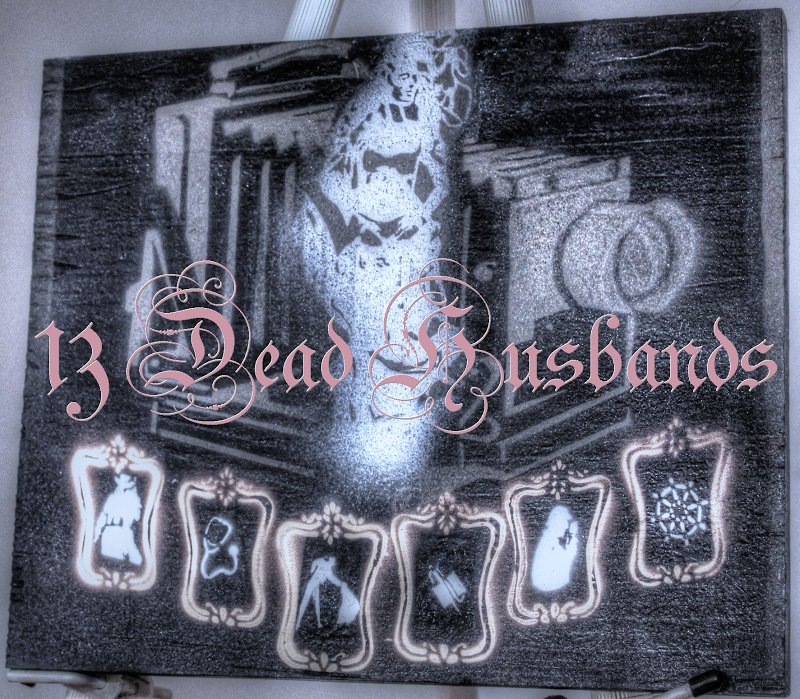We’ll tell you a tale marvelous told. Of a beautiful girl like the stories of old. The most wondrous girl, and not just by chance…this story here happens inside of— Weird France? The Baltimore Area premier of Tom Horan’s 13 Dead Husbands is making waves…or perhaps corpses…over at Cohesion Theatre Company. As the second production of their inaugural season, this dark and humorous fairytale takes place in a “Paris of the imagination.” In a TheatreBloom exclusive 3-Part series entitled “Welcome to Weird France” we go behind the scenes with the designers and performers of this exciting new work, which has only previously received one production in Chicago, and get into life inside of #weirdfrance. Kicking off the series are Costume Designer Stephanie Fisher, Scenic Designer Sebastian Sears, and Director Brad Norris.
Let’s get a round-robin introduction of who is who and go from there, shall we?
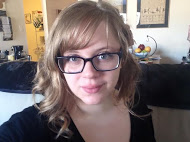
Stephanie Fisher: My name is Stephanie Fisher. I am the costume designer for— what is this show called?
Brad Norris: 13 Dead Husbands!
Stephanie: I’m sorry, I’ve been at work all day, my brain’s not working. But I just moved to Baltimore in August. I’ve been working as a stitcher in the costume shop at Washington National Opera for some time. I ran wardrobe for The Tempest at Shakespeare Theatre Company for a time. This is my first thing in Baltimore and I’m really excited about it.
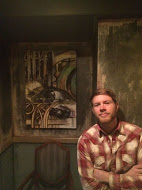
Sebastian Sears: My name is Sebastian Sears and I am the Scenic Designer for the production of 13 Dead Husbands.
Brad: Did he say Scenic Designer?
Sebastian: Scenic Designer. Set Designer. Tomato. Tomahto. What’s the difference?
Stephanie: I think it’s an education thing.
Sebastian: It’s definitely that. I’ve been in Baltimore for about a year and a couple months now but this is the first set production in Baltimore I’ve actually started and been a part of. I did actually stage manage for the first time about a year ago for the production of 4 By Chekhov at Fells Point Corner Theatre. It was a fun experience. I haven’t really done any theatre between then and now but I am an artist. I’ve gotten involved with Gallery 788 over in Hampden. I do a lot of mixed media art on plywood.
So I keep hearing the term “WeirdFrance” being thrown around (Spoiler— these interviews were recorded in reverse order that they are being published) Can you explain a little bit about what it’s like to design for a surreal absurdist fantasy show that has a specific and yet simultaneously not specific time and location?
Sebastian: Surprisingly it’s difficult, but really fun. As Brad (Brad Norris, Co-Founder of Cohesion Theatre Company and Director of 13 Dead Husbands) was mentioning it doesn’t have to be a set period of time. You can go balls out and it can be as unrealistic as possible.
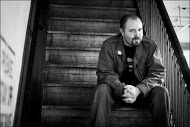
Brad: You said balls. I like that.
Stephanie: For me it’s really fun because I’ve done a lot of contemporary pieces, which I like doing because I like the pieces. I did Next To Normal in Cleveland and I love the piece, so it’s very fun from that perspective, but the clothes aren’t that interesting. I mean ours was cool because they were all shades of black and gray, so there was some interest to it but it’s contemporary clothing. I’ve also done period pieces, which are fun because the clothes are fun, but I never have the budget that I want to have for them.
So to do a surreal piece is probably the most fun because I can do whatever I want within Brad’s guidelines. And that’s the best you can ask for.
Brad: And within Brad’s budget. Within Brad’s budget.
Stephanie: Oh. Right. Budget. No, I’m actually really good at the budget part. Although I did ask for more money the other day. But it was only like $25 not an exorbitant amount. I’m really good at budgeting other people’s money.
As a Scenic Designer, we’re looking at Paris-not-Paris?
Sebastian: Try imagining an all over the place…not a certain decade…but like bits and pieces of each decade here and there.
Are there any certain icons or imagery that you’re using to influence your design?
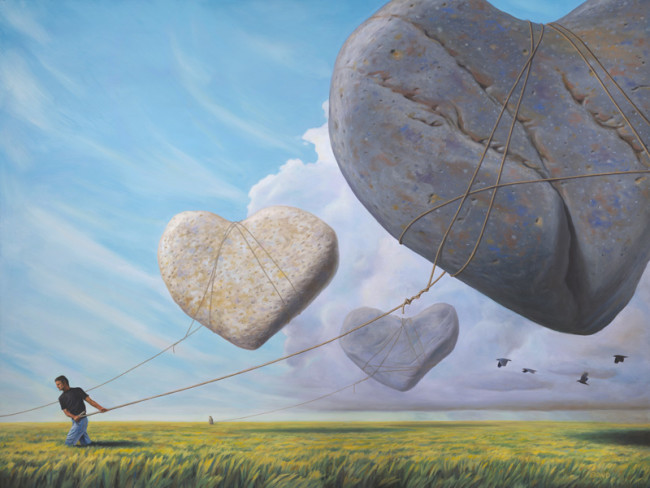
Sebastian: For the most part it’s been looking for references online. It’s a surrealistic piece. I’ve been going to rehearsals— I try to make a rehearsal once a week— just to figure out the actors. All the husbands have a specific…theme? At least the ones that have died do anyway. Nature, that’s a better word. Their profession has a specificity to them and that has influenced what I’m going to paint.
What about you, Stephanie? What’s inspiring your creations in the costume department?
Stephanie: Brad got me started with a Chagall painting that he said was his inspirational image. So I went from there and riffed on that and downloaded a bunch of Chagall images. They are surreal. It’s a world that’s familiar but not completely which I think is kind of what we’re going for. We want the audience to know that it’s Paris but not to feel like it’s the Paris that they’ve heard about or been to.
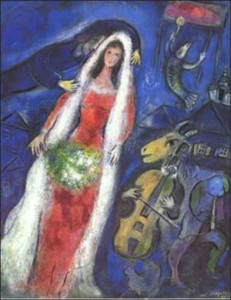
I started there and I looked up other artistic movements in the vaguely Post-World War I era which we talked about. Not a set year, not a set decade, but sort of a 20’s and 30’s influence. I happened upon Magic Realism, which I would have to look at the definition again to really define it well, but it was a movement in the 30’s that developed alongside Surrealism and led into neo-Romanticism …it’s been weeks since I did this initial research.
I really like Magic Realism because it gave me some really good images of people. But surreal. It also gave me really, really good color palette for this show. So between Chagall, the Magic Realists from the 1930’s and the contemporary Magic Realists I found a lot of really interesting inspirational images for me. I supplemented that with a 1930’s Sears catalog and images of actual clothes that I found online. I’ve sort of collaged it all together in my head.
What has been the biggest challenge for you two as designers?
Brad: Do not say the budget.
Stephanie: Damn it.
Sebastian: I know recently we’ve had to acquire a new space. We’ve settled on The Church in The Square over in Canton, which is different from where we started, and different from where we’re rehearsing—
You guys go through a lot of churches…
Brad: We’re church hoppers.
Stephanie: We’re like traveling minstrels…
Sebastian: Theatre gypsies!
Brad: If we weren’t already called Cohesion Theatre…Theatre Gypsies would definitely be our second name. The Theatre Gypsies. That just sounds suave. I think we’ll save that for when we all get really old and need to start a young company: The Theatre Gypsies.
Stephanie: They’re the Cohesion interns.
Brad: Yes! The Cohesion Interns. And they all live in a van outback together. A caravan.
Sebastian: There is suddenly this image of—
The Scooby Doo mystery crew trying to do theatre in the back alley.
Stephanie: Oh my god that sounds like a trainwreck.
Sebastian: They live in the mystery machine. Which would be quite the challenge to do theatre from. Which takes us back to your question, the challenge. Which was what— what was I saying— oh, having the new space! Right. I don’t know, now that I think about it, that it was so much of a challenge as it was a delay in getting to really start on the design work. For me, I want to see the inside of the space and get measurements and visualize what I’m working with. I want to get blueprints made up in my mind and on paper of what my space is like. It gives me an idea of what sizes of materials I’ll need and stuff like that.
I think the other challenge is now that the space has changed— our original space had blank walls that I could paint all over— this space is a regular sanctuary, so I can’t paint on the walls anymore. They hold a lot of other events in this sanctuary, they do classes and services, there’s actually a wedding that’s going to happen during the course of our run. So now I’m looking at making everything collapsible and portable. All the set elements need to be lighter so that they are easier to put up and take down in-between showings. I feel like once we get into the space and get some drawing up, it’ll be a lot easier.
What about you, Stephanie, design challenges?
Stephanie: Besides the budget…
Brad: You had to get that in there, didn’t you.
Stephanie: Yes. To be fair, it is really hard to do ten people in costume plus a band…but I’m doing it! Yes, there’s a band. And they’re in costume. You’ll have to see the show to see more about that. I would say the biggest challenge for me is figuring out how to be a Costume Designer in a city that I don’t know very well. It’s really not about the piece; it’s about where do I go thrifting and what’s not open on Sundays. I’m learning the hard way. In Cleveland I knew the hours, the half-off days, the color-tag rotation; I knew every detail. I would walk into Salvation Army and every time I would come up to the register they would ask me if it was tax exempt. They knew that I was the tax exempt lady. I actually taught most of them how to do tax exempt. That’s been really hard, making that adjustment.
But the nice thing is that because I travel to DC every day anyway, I’ve been able to broaden my radius of shopping for the show. This makes everything a lot easier. I actually spent one day where I started in Silver Spring and came back north and I hit up 15 thrift stores in one day. For me that’s fun. I’m glad I had a week off where I was able to just focus on that. I did most of my shopping in three days and now I’m just filling in the gaps.
A lot of designers have a signature. How are you putting your signature or making your mark present in this show?
Stephanie: I actually think that so far I’m fighting that notion a little bit. I’m very afraid of designing shows that look the same. I’ve had the privilege to work with many different Scenic Designers who have very different styles and I think that has kept me on my toes. I don’t think I’ve— I’m not a fully developed designer yet. I only have an undergraduate degree and my undergraduate degree only focused on arts management. So I’ve kind of learned everything as I’ve went. I don’t know that I have a signature yet. I guess my strength is that I’m very good at research. That can be a weakness too, though, because you get into a surreal show like this and you have to stray from the research. Sometimes that’s really difficult for me. It hasn’t been too bad for this one, yet.
How are you putting you into the work since you don’t have or are fighting having a “signature” element?
Stephanie: I don’t know. I haven’t thought about it. Ask Sebastian and I’ll think about it.
Sebastian: I’m set just kind of being like go with the flow. I’ve picked up a lot of layering, especially when it comes to my mixed media work. It’s like a surrealist collage approach. I figured that’s why Brad chose me because that style of my artwork really speaks to his vision for the show. So if you see a lot of layering going on…then you know it’s mine.
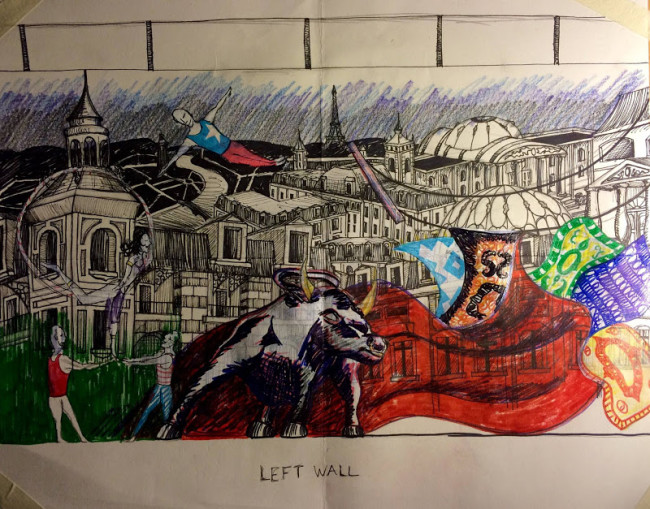
Was that enough thinking time, Stephanie?
Stephanie: No! I guess I hadn’t thought about— I don’t think I’ve ever thought about being a Costume Designer in that way because the job changes so much from production to production. I have a friend who is a Scenic Designer in Cleveland and he’s incredible and I love working with him. People walk into his shows and they say “That’s a Trad show” but I don’t know what it is that makes them say that. I don’t know that I have that yet.
Brad: I’m going to jump in real quick. One of the things that attracted me and Alicia (Cohesion Theatre Company Co-Founder Alicia Stanley) and all of us who looked at your portfolio, was this energy and this life that existed in all of the work that you’d previously done. There were some images from A Midsummer Night’s Dream that we looked at and we all were just like “My God! These are so beautiful!” And then there were other pieces that were a bit more modern and straight but they still popped. It didn’t feel like boring Arthur Miller or like something everyone had seen. They had a real indescribable life to them.
The research that she’s done for this show? She’s 100% right. She came back with so much material. Literally, I showed her one Chagall. And talked to her about my thoughts on it. She came back and she showed me on her phone all of these images she had pulled. It was crazy.
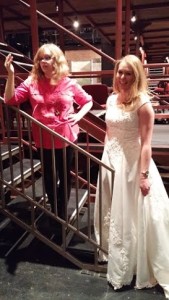
Stephanie: That Midsummer Night’s Dream project was from college. We had to do all of this research for it and use actual books. Every piece that we put into our show bible, we had to justify. Every single piece of research had to be justified. So that’s how I work. I am pulling from this picture this pair of shoes. And then from this picture I am taking the color palette. And from this picture I’m taking the hairstyle. So that’s how I come at everything. We also worked with very strong concept statements for that project. That’s my favorite way to work. I don’t know that we did that in the same way with this show? But there’s a feeling that’s there and that’s enough for me. I didn’t have to make words. I mean I have been thinking about it, but I haven’t been able to find the right words for it yet.
Brad: WeirdFrance.
Stephanie: WeirdFrance.
Sebastian: WeirdFrance.
Stephanie: That feeling— WeirdFrance— that’s enough for me for this. I think that might be my me. I think I just had to talk it out. Thank you, Brad.
Brad: Glad to be useful.
Why should people come and see this strange production at Cohesion Theatre Company?
Stephanie: So many reasons. I haven’t worked at other Baltimore theatres so I cannot speak to the way that they work. However, I can speak to the way that Cohesion works. And it has been such an incredible collaborative process of working here. The audience is the last piece of that collaboration that need to make it a fully realized beautiful production.
This is another thing from school that I feel really strongly about. If it’s not a collaborative process, I’m not interested in doing it. All of that work as a group will show so much in the production. That’s what’s going to make this company stand out from other theatres. I think that sometimes the longer a non-profit tiny theatre group is around the harder it is to maintain that collaborative spirit. So a new one needs to come and kick everybody in the pants and make everybody realize that they’re not doing it. That’s Cohesion.
I also think the script is just absolutely charming. It’s slightly macabre but a really feel-good show. I think everybody will leave the show in a really good mood. The title has the word dead in it and there are lots of dead people but that’s not really how the show feels.
Sebastian: This is not a serious “oh, they’re dead” sort of play. There’s a funny aspect to it.
What’s your take on “why come see it?”
Sebastian: I think Stephanie nailed it, honestly. I haven’t really worked with a small-scale theatres either. But definitely what she said about the collaboration. The audience is definitely that last key part. I almost think all the design and acting is coming together. I have a really good feeling— a gut feeling that this is just going to turn out great.
She’s got words, you’ve got a gut feeling. What more do you need?
Stephanie: We also have Brad.
Sebastian: Oh yeah Brad!
I know that you guys already have #weirdfrance but based your involvement and knowledge of the show, what’s the appropriate #handle for this show?
Stephanie: Oh my goodness.
Sebastian: A hashtag?
Stephanie: I don’t use hashtags! This is especially difficult for me.
Sebastian: I’m not a writer…I’m an artist. I have no idea. Um…this is where I take up the rest of the tape trying to come up with a good handle. #notawriter
Stephanie: I got nothing.
Brad: My designers are designers. They are not word people.
Sebastian: We’re not 19.
Brad: Burn. #insidejoke
What about you, Brad? Do you have a hashtag for this?
Brad: This show has been in my head since—
You sound like Jonas.
Brad: 2008! Only 2008. I swear. A reasonable amount of time to think on a show. I saw the original and only production in Chicago and I loved it. I went and saw that show three times in the course of its limited three-week run. It was so exciting and it was so fun. Like Stephanie said, there’s a feeling that you have walking out of the show that even though it’s macabre and dark and weird, and the title leads you to believe that it’s going to be closer to The Addams Family than to Notting Hill. One of the great things that I really truly love about this show is that it is not happily ever after in the traditional sense. We don’t have to have a wrapped up fairytale to still have a happy ending.
Stephanie: It’s interesting that the show is surreal and doesn’t take place in this time or in this world, but at the end the feeling you get and the message that’s given are real life. You don’t have to be in real life right here right now to get at real life.
Maybe…#fairytalereality
Sebastian: Wow! That’s a good one.
Brad: That’s why she’s a writer. Come see our show. #weirdfrance
13 Dead Husbands plays through March 29, 2015 at Cohesion Theatre Company currently performing at The Church on The Square— 1025 s. Potomac Avenue in Baltimore’s charming Canton neighborhood. Tickets can be purchased at the door or in advance online.

